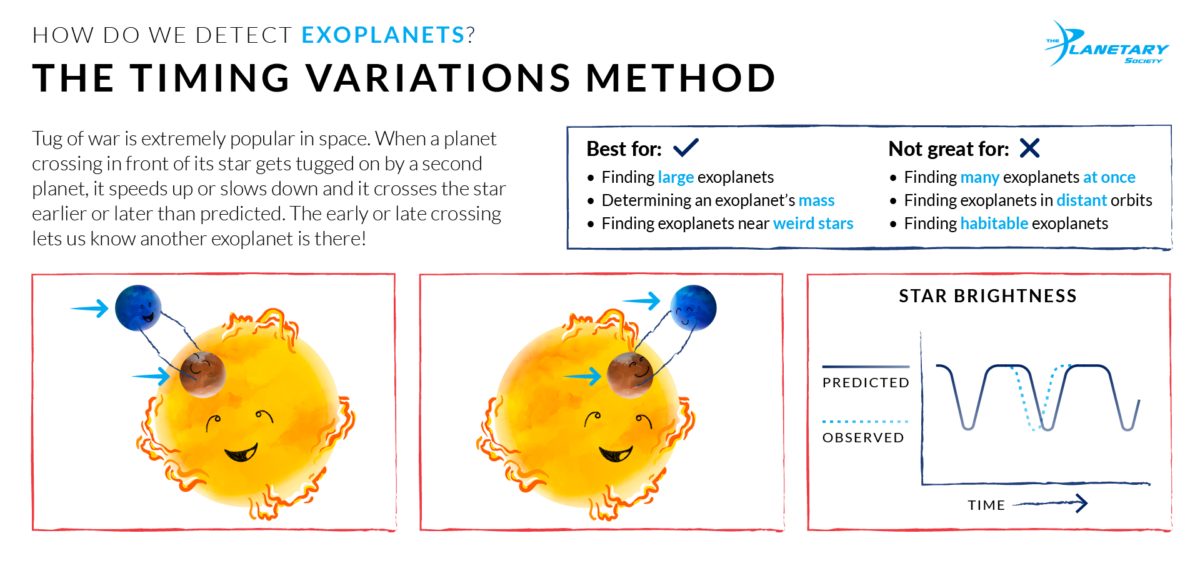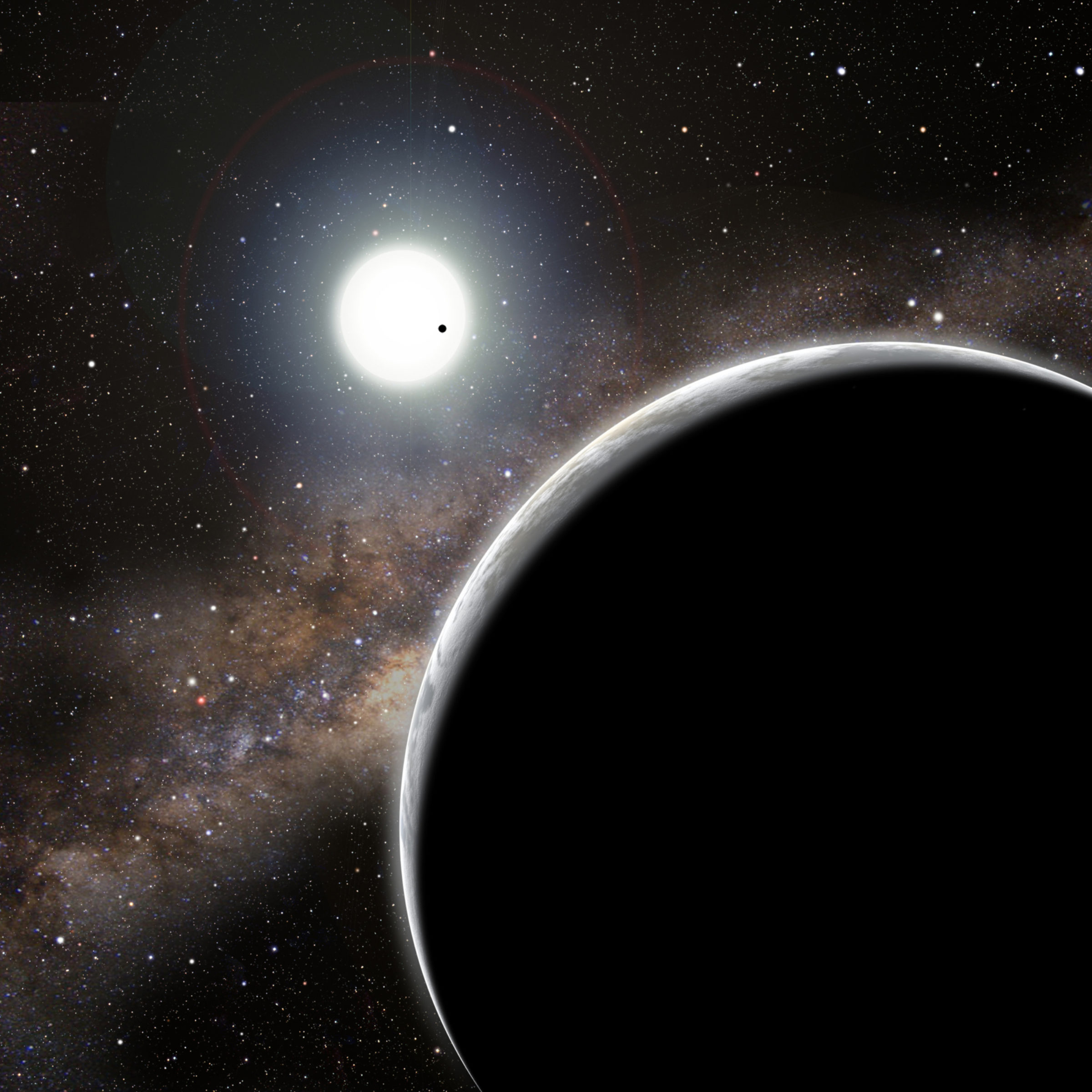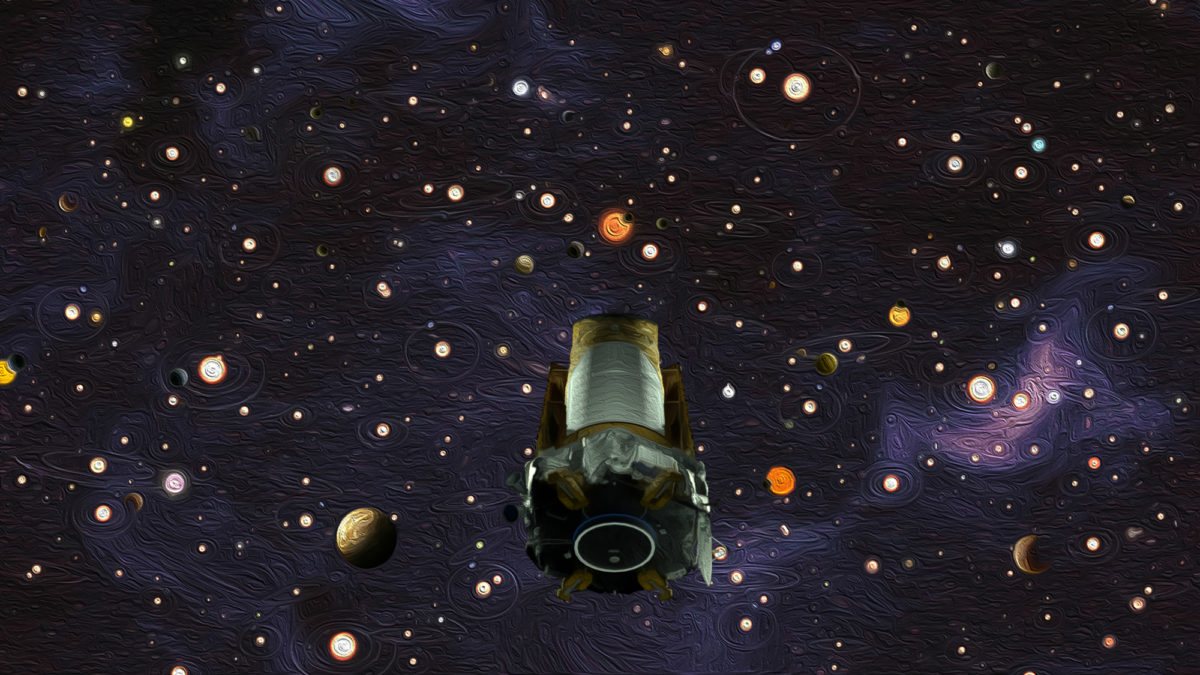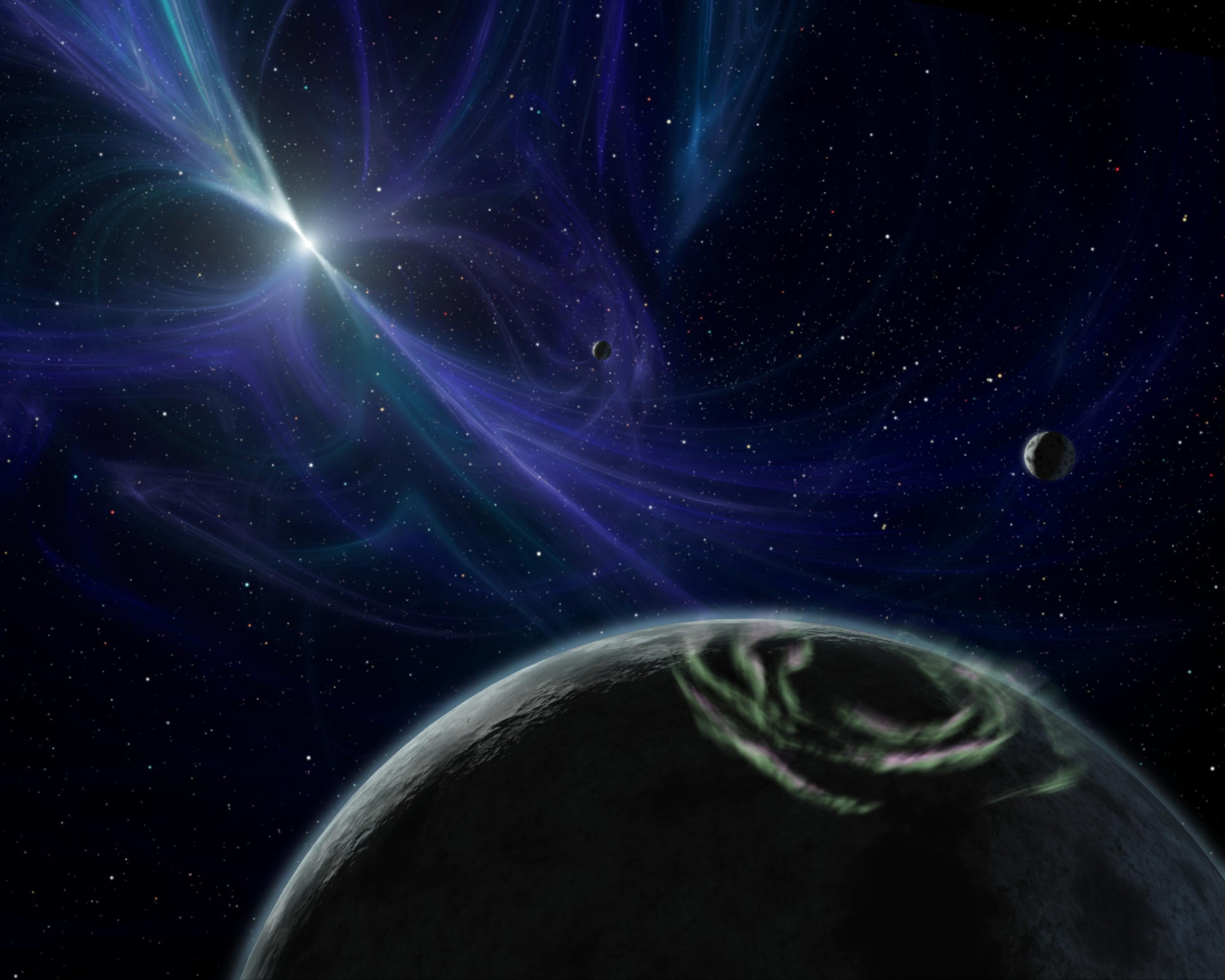Timing Variations
Unseen planets can make themselves known by the gravitational tugs they exert on other planets and stars. These tugs cause variations in the timing of predictable events like planetary transits, binary star eclipses, and natural pulses in radiation from stars. By observing timing variations, astronomers can infer the presence of another world.

Although it is usually used to detect exoplanets, one of the planets in our own solar system was discovered through observation of timing variations. In the 1820s, astronomers noticed that Uranus moved slightly faster or slower in its orbit around the Sun than expected. In 1845, several astronomers predicted that another, more distant planet was affecting Uranus’ motion, and Neptune was discovered close to the predicted location in 1846.
There are several flavors of timing variations that have been used to find planets outside our solar system, each with advantages and disadvantages. As of February 2020, the NASA Exoplanet Archive listed 21 planets discovered by the transit timing variation method (also known as transit photometry), 16 using the eclipse timing variation method, 7 using the pulsar timing variation method, and 2 using the pulsation timing variation method. Visit the NASA Exoplanet Archive using the links in the previous sentence for up-to-date counts.

Transit Timing Variations
Many extrasolar planets have been discovered by watching them transit (cross in front of) their stars. Although we can’t see the planet itself, we can see the dip in brightness of the star as the planet blocks some of it from Earth’s view. We expect transiting planets to go around like clockwork, always taking exactly the same length of time to complete an orbit. For many transiting planets, however, that's not what we observe; the transit happens slightly too early or too late compared to the prediction. This is an indication that there's an unseen planet also present in the system and tugging gravitationally on the transiting planet.
Kepler-19c was the first planet discovered by the transit timing variation method in 2011. Astronomers detected transits of its sibling planet, Kepler-19b, but noticed that these transits arrived as many as five minutes later or earlier than expected for an unperturbed planet, so they deduced the existence of Kepler-19c. Because it did not cross its star, further Kepler observations couldn’t yield much information about planet c, but followup radial-velocity measurements enabled astronomers to pin down its mass and orbit (and revealed a third planet in the system, Kepler-19d).
Advantages:
Beyond the method’s value for planet discovery, transit timing variation measurements enable calculations of the mass of transiting planets. Usually, we can only figure out transiting planets’ masses by observing them in a second way, using radial-velocity measurements of the star. If the planet’s mass is too low, radial-velocity measurements won’t work (The Planetary Society’s exoplanet program is helping astronomers advance radial-velocity detection technologies to find smaller and smaller planets). But if there is a second planet in a system causing transit timing variations, only one kind of observation—transit photometry—is needed to determine the transiting planet’s mass.
Additionally, transit timing variations are most easily detected when neighboring planets orbit in resonance with one another. Resonance happens when the ratio of the orbital periods of the two planets is close to a ratio of whole numbers—for example, if two planets are in a 3:2 resonance, the inner planet goes around the star 3 times for every 2 orbits of the outer planet.
Every time the resonant planets align, they’re as close to each other on their respective orbits as it’s possible to be, so the gravitational tug they exert on each other, and the resulting offset of the predicted transit time, are as strong as possible. This makes the transit timing variation method especially sensitive to resonant planets, which are important for studying how planetary systems formed. Planets that align so neatly probably have a quiet formation history, without disruptive gravitational encounters like the ones that happened when the giant planets in our solar system shifted in their orbits.
Disadvantages:
The transit timing variation method only works for systems that contain transiting planets – that is, systems that contain planets whose orbital planes are edge-on as seen from Earth. However, since the transit photometry method of exoplanet discovery is the most productive one, this isn’t much of a limitation.

Eclipse Timing Variations
Eclipsing binary stars are pairs of stars that orbit each other and cross each other’s faces as seen from Earth. The brightness of the whole system varies as one star blocks the other’s light. Like planetary transits, eclipsing binaries should have a regular repeating rhythm, but a planet orbiting around an eclipsing binary star system can cause the binary eclipses to arrive too early or late. Eclipse timing variations can reveal otherwise invisible planets in stellar systems that are already very well-studied by astronomers.
Advantages:
Binary star systems are extremely common. Indeed, more than half of all stars belong to binaries. But only a handful of circumbinary planets, or planets orbiting binary star systems, are known, and finding more is key to understanding how such systems form. The current best hypothesis for why we know of so few circumbinary planets is that most circumbinary planets form far out from the binary, from a wide protoplanetary disk encircling both stars, and then migrate closer over time. Since they are far away from the stars, the planets’ gravitational effects on the stars are subtle and difficult to detect.
Disadvantages:
Like the radial-velocity method, the eclipse timing variations method relies on detecting planets’ influence on much heavier stars, so it can only detect heavy planets.

Pulsar Timing Variations
Pulsars are weird stellar objects that emit regular pulses of radio waves, often quite fast. They are neutron stars—the rapidly rotating, ultra-dense leftover cores of exploded giant stars. The radio pulses happen because of the powerful magnetic fields generated in pulsars. The pulses happen with every stellar rotation, and should be regular unless something like a planet perturbs their timing. The first exoplanets ever discovered, in 1992, were found by timing variations of the pulsar PSR B1257+12.
Advantages:
Pulsar planets are laboratories for understanding exotic planet formation pathways. Pulsars themselves are the remnants of supernovae, explosions so powerful that they would destroy any existing planets around the exploded star. Any planets found around pulsars must therefore have been either captured from somewhere else or formed after the supernova. Such planets could form from debris left behind by the explosion, or from the remnants of a former binary companion star to the pulsar that was blasted away by the pulsar’s extreme radiation or disrupted by its extreme gravity.
Disadvantages:
Pulsars themselves are quite rare, and planets orbiting pulsars rarer still. Only 7 confirmed exoplanets have been discovered this way so far.
In addition to radio waves, pulsars emit intense high-energy electromagnetic radiation. Many are bright in x-rays, and some even in gamma rays. We would not expect planets bathed in this emission to be habitable.
Some giant and supergiant stars pulsate, regularly increasing and decreasing in brightness as their outermost envelope of hot gas rhythmically expands and contracts over a period of hours to years. These are variable stars, which are very well studied by astronomers. If variable stars have planetary companions, the planets can tug the stars back and forth, causing the light pulses to arrive at Earth earlier or later than expected.
Pulsation Timing Variations
Advantages:
Planets around giant, massive pulsating stars are difficult to find by any other methods. Their pulsating variations in brightness make it very difficult to search for small dimmings due to planet transits. Furthermore, pulsars tend to rotate fast, and this rotation widens their spectral lines, making small radial velocity shifts due to orbiting planets extremely difficult to detect. Although hard to measure, pulsation timing variations are the best bet for finding planets around such extreme stars.
Disadvantages:
Pulsation timing variations can only be detected if the star’s pulsations are ordinarily extremely regular, which is rare. As a result, only 2 confirmed exoplanets have been discovered by this method so far.
This article was written by Emily Sandford and Planetary Society staff writers.
How to Search for Exoplanets
Some methods almost sound like science fiction: Using gravity as a magnifying glass, watching stars wobble at turtle-like speeds, and searching for tiny dips in starlight.


 Explore Worlds
Explore Worlds Find Life
Find Life Defend Earth
Defend Earth


